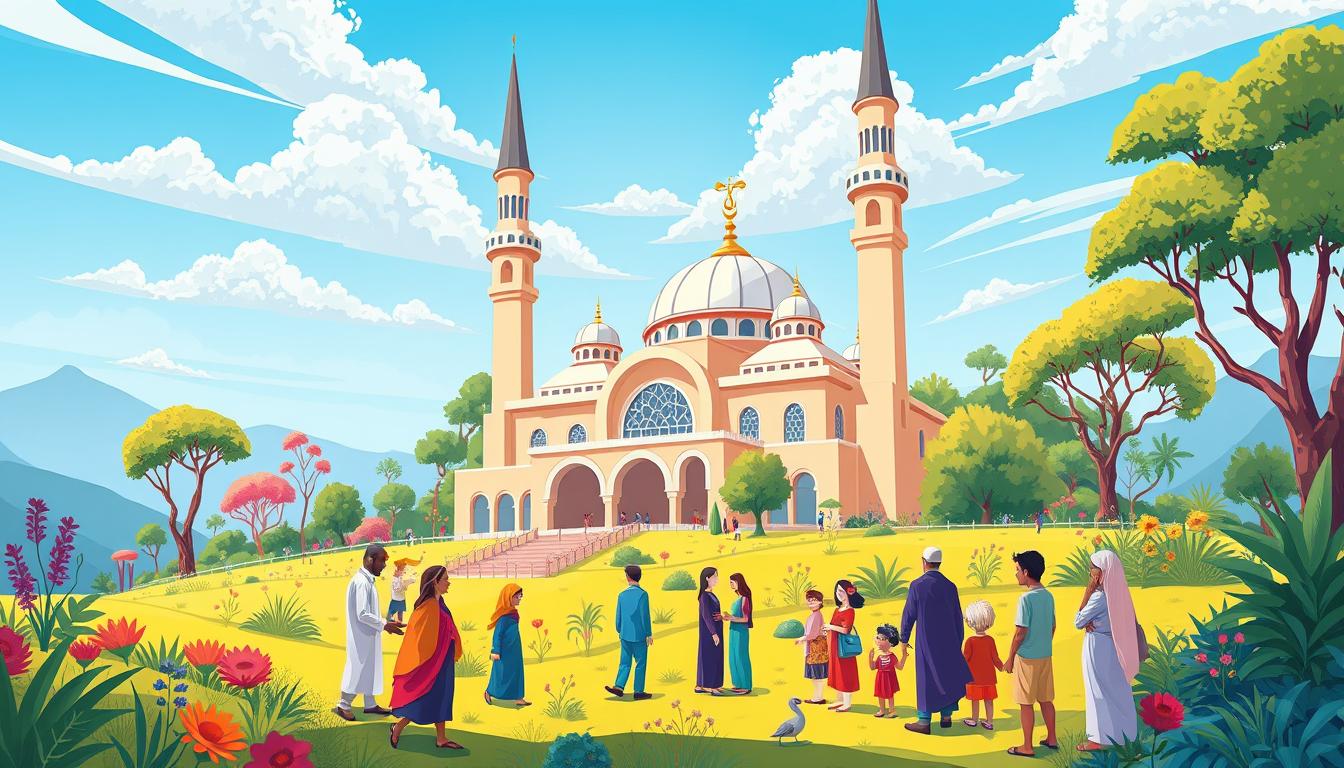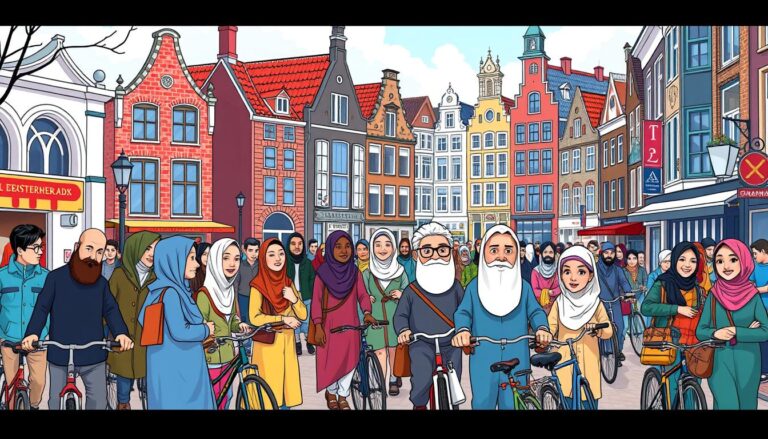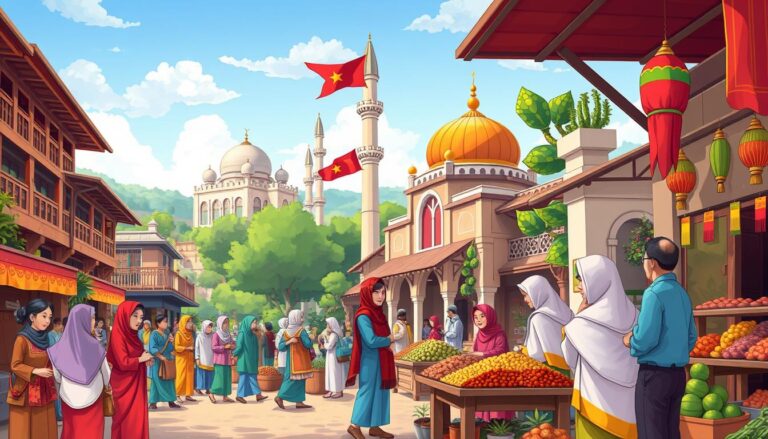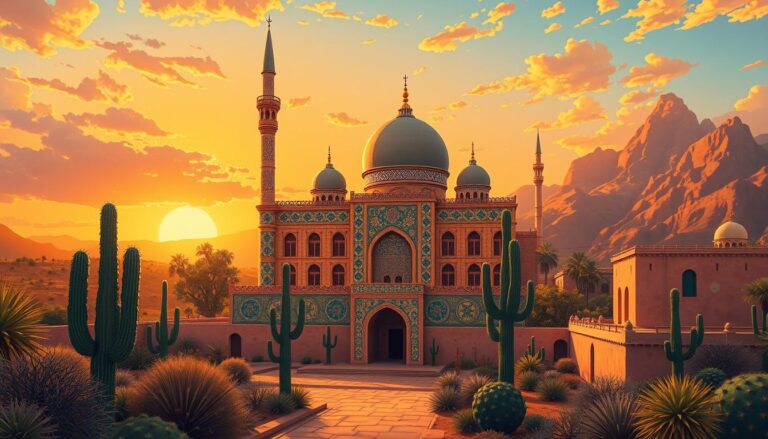Islam in Australia
With over 813,392 adherents, Islam is the second-largest religion in Australia, comprising 3.2% of the total population according to the 2021 Census. This diverse community, representing a wide range of racial, ethnic, cultural, and linguistic backgrounds, is an integral part of the Australian social fabric.
The vast majority of Australian Muslims are Sunni, with significant minorities belonging to the Shia denomination, as well as smaller denominations such as Ibadi and Druze. Islam has a long and vibrant history in Australia, with the presence of Makassan traders and Afghan cameleers in the outback serving as early evidence of the religion’s enduring influence in the region.
As the Muslim community in Australia continues to grow and evolve, it is essential to understand the nuances of its diverse cultural and theological practices, as well as the challenges it faces in terms of integration and social acceptance. This article will explore the rich tapestry of Islam in Australia, delving into its historical roots, demographic trends, prominent organizations, and the contributions of Australian Muslims to the nation’s social, cultural, and economic landscape.
Key Takeaways
- Islam is the second-largest religion in Australia, with over 813,000 adherents comprising 3.2% of the total population.
- The Australian Muslim community is highly diverse, representing a wide range of racial, ethnic, cultural, and linguistic backgrounds.
- Islam has a long history in Australia, with the presence of Makassan traders and Afghan cameleers in the outback serving as early evidence of the religion’s influence.
- Understanding the nuances of the diverse cultural and theological practices within the Muslim community is crucial to fostering integration and social acceptance.
- The contributions of Australian Muslims to the nation’s social, cultural, and economic fabric are significant and worthy of recognition.
Historical Roots of Islam in Australia
The history of Islam in Australia stretches back centuries, long before the country’s European colonization. The early history of Islam in Australia can be traced to the interactions between Makassan traders from Indonesia and the Aboriginal communities of Arnhem Land (now part of the Northern Territory) as early as the 1700s.
Evidence of this Muslim influence on Aboriginal culture can be seen in the cultural similarities between the Makassan and Aboriginal traditions, including the use of the Arabic phrase “Walitha’ walitha” (an adaptation of “Allah ta’ala”) in Warramiri ceremonies.
Afghan Cameleers: Pioneers of the Outback
In the 19th century, Afghan cameleers were among the earliest Muslim settlers in Australia, arriving to work as camel drivers in the Australian outback. These Afghan cameleers played a vital role in the development of the country’s infrastructure, such as the Overland Telegraph Line and the Ghan Railway line.
“The Afghan cameleers assisted in opening the interior of Australia, transporting goods and people across the vast and harsh landscape.”
The presence of these Afghan cameleers marked a significant chapter in the early history of Islam in Australia, paving the way for a more permanent Muslim settlement in the country.
Demographics and Diversity
The Muslim demographics in Australia showcase the ethnic diversity within the community. According to the 2016 Census, the major countries of origin for Australian Muslims include Australia (36%), Lebanon (10%), Turkey (8%), Afghanistan (3.5%), Bosnia-Herzegovina (3.5%), and Pakistan (3.2%).
Geographically, the geographic distribution of Muslims in Australia is concentrated in the populous eastern states, with the largest populations residing in New South Wales (50%) and Victoria (33%). Other states and territories have smaller but growing Muslim communities.
Ethnic Backgrounds
The ethnic diversity of Australian Muslims is evident in the wide range of ethnic backgrounds represented. The community includes individuals of Arab, Turkish, Afghan, Bosnian, Pakistani, and various other ancestries, reflecting the global reach of Islam.
- The 2001 Census data showed that Australian Muslims come from over 70 different countries of origin.
- This diversity is a testament to the inclusive and welcoming nature of the Australian Muslim community.
“The Australian Muslim community is a mosaic of cultures, traditions, and experiences, united by their faith.”
Islam in Australia
Islam has a significant presence in Australian society, with Muslims representing the second-largest religious group in the country. Australian Muslims maintain their religious practices and identity, while also integrating into the broader multicultural fabric of the nation. The Australian Muslim community is not monolithic, with various sects and sub-groups co-existing and contributing to the diversity of Islamic expression in the country.
According to the 2016 census, there are 604,200 Muslim Australians, which make up 2.6% of the total Australian population of approximately 23.4 million. Almost 40% of Muslim Australians are Australian-born, while approximately 60% are born overseas. A significant number of Muslim Australians have migrated from countries such as Afghanistan, Bangladesh, India, Indonesia, Iran, Iraq, Lebanon, Pakistan, and Turkey, as well as from Bosnia, Egypt, Fiji, Malaysia, Somalia, and over 150 other countries, making the Muslim community in Australia highly diverse in terms of ethnicities and cultures.
The population of Muslims in Australia almost doubled from the early 1970s to the mid-1990s when it first exceeded 200,000 people. Between 1986 and 1991, Australia’s Muslim population experienced a growth rate of 35% primarily due to immigration, with nearly 100,000 Muslims arriving in Australia during that period, mostly from the Middle East.
While the majority of Australian Muslims practice their faith peacefully and contribute positively to society, the rise of anti-Islam/anti-Muslim sentiments in recent years has posed challenges for the community. Studies and polls indicate that between 25% to 50% of the Australian population harbor such sentiments, and social movements and political parties with explicit anti-Islam agendas have emerged in the country.
“Muslims believe they are constantly asked to prove themselves and demonstrate their loyalty to Australia, which they find exhausting, humiliating, and ultimately alienating.”
In response to these challenges, the Australian Muslim community has continued to engage with the broader society, promoting interfaith dialogue, cultural exchange, and community integration. Despite the difficulties, the Islamic identity in Australia remains a vital and vibrant part of the nation’s multicultural fabric.
Prominent Islamic Organizations
The Australian Muslim community is represented by a number of prominent Islamic organizations that play a crucial role in advocating for the rights and interests of the diverse Muslim population across the country. These organizations include the Australian Federation of Islamic Councils (AFIC) and the Islamic Council of Victoria (ICV).
Australian Federation of Islamic Councils (AFIC)
Established in 1964, the Australian Federation of Islamic Councils (AFIC) is considered the most important Islamic organization in Australia. AFIC serves as the national umbrella body, representing the interests of the Muslim community nationwide.
Islamic Council of Victoria (ICV)
The Islamic Council of Victoria (ICV) is another prominent Islamic organization that represents the interests of Muslims in the state of Victoria. The ICV works closely with the Muslim community organizations in the region to address their concerns and promote their well-being.
These Islamic organizations, along with others like the Australian National Imams Council (ANIC), the Lebanese Muslim Association, Crescents of Brisbane, Muslim Aid Australia (MAA), and the Muslim Women’s Association (MWA), play a vital role in the Australian Muslim community. They advocate for the rights of Muslims, promote cultural integration, and work to address challenges such as Islamophobia.
“The Alliance of Australian Muslims (AAM) is comprised of over 200 grassroots mainstream Muslim organizations across Australia, working with both Government and Non-Government organizations to address key challenges facing Australian Muslims and society.”
Cultural Integration and Challenges
The Muslim community in Australia has made remarkable strides in integrating into the country’s diverse and multicultural society. However, the journey has not been without its challenges, as the community has had to navigate issues of Islamophobia and discrimination.
Embracing Multiculturalism
Australian Muslims have actively embraced the nation’s rich cultural diversity. They have contributed to the vibrant fabric of Australian society, sharing their traditions, cuisine, and artistic expressions. Many Muslim Australians have found a sense of belonging and acceptance, with over 80% reporting a high proficiency in English.
Despite these successes, the Muslim community continues to face obstacles. Islamophobia, or the fear and intolerance of Islam, remains a persistent issue. Incidents of discrimination and hate crimes have led to a sense of isolation and marginalization for some.
Addressing Islamophobia
Efforts to address Islamophobia and promote mutual understanding are ongoing. Islamic organizations, such as the Australian Federation of Islamic Councils (AFIC) and the Islamic Council of Victoria (ICV), have spearheaded initiatives to foster interfaith dialogue and education. These initiatives aim to break down stereotypes, promote respect, and create a more inclusive environment for all Australians, regardless of their religious or cultural background.
As the Muslim population in Australia continues to grow, with 61.5% of Australian Muslims being immigrants and 39.5% being Australian-born second-generation Muslims, the need to address cultural integration and Islamophobia remains a pressing concern. By embracing diversity, promoting understanding, and addressing discrimination, the Australian Muslim community and the broader society can work towards a more equitable and harmonious future.
“The strength of Australia is in its diversity. By celebrating our differences and finding common ground, we can build a society where everyone feels welcomed and respected.”
Islamic Architecture and Mosques
Islamic architecture and the construction of mosques have played a pivotal role in the visual representation of the Muslim community in Australia. The Adelaide Mosque, built in 1888-89, is considered one of the oldest mosques in the country and serves as an important symbol of the long-standing presence of Islam in Australia. Other historic mosques, such as the Marree Mosque and the Central Adelaide Mosque, also reflect the evolution of Islamic architectural styles and the community’s efforts to establish religious spaces across the nation.
Historic Mosques in Australia
The first Australian mosque was built in Marree, South Australia, in 1861, marking the arrival of Islamic places of worship in the country. Over the decades, the architectural landscape of mosques in Australia has continued to evolve, with structures like the Melbourne Grand Mosque, which can accommodate 2,000 worshippers and cost A$8.5 million to build. The mosque in Melbourne also includes a sporting centre, a community hall, and a childcare centre, showcasing the diverse functions these Islamic spaces serve.
While traditional mosques in Australia have not featured high domed roofs, favoring transparency over enclosure in their facades, more contemporary structures like the Australian Islamic Centre in Newport, Melbourne, have reimagined the form of the minaret as an elevated wall demarcating an arrival courtyard. Designed by renowned architect Glenn Murcutt, the Australian Islamic Centre features twenty-four steel columns arranged to reflect traditional mosque geometry, creating three bays from east to west and three from north to south. The main prayer hall is illuminated naturally by fifty-five three-meter-high roof-mounted lanterns glazed in colors symbolic to Islam (yellow, green, blue, and red).
“The mosque respects traditional architectural features such as a central dome above the prayer hall, while incorporating contemporary design elements that cater to the needs of the modern Australian Muslim community.”
The construction of the Australian Islamic Centre in Newport, Melbourne, which took place from 2006 to 2018, is a testament to the community-led efforts and the evolving nature of Islamic architecture in the country. These historic and contemporary mosques serve as visual representations of the diverse cultural and architectural influences that have shaped the Muslim community in Australia.
Celebrating Islamic Events and Festivals
The Australian Muslim community actively celebrates a variety of Islamic events and festivals throughout the year, reflecting the diverse cultural and religious traditions of the community. These celebrations, such as Eid al-Fitr and Eid al-Adha, are important occasions for the community to come together, observe religious practices, and share their cultural heritage with the broader Australian society.
One of the most significant Islamic events is Ramadan, the holistic month of fasting for Muslims. During this time, healthy adult Muslims fast from dawn to dusk, refraining from eating, drinking, and other activities. The end of Ramadan is marked by the joyous celebration of Eid al-Fitr, a three-day festival that encourages community, forgiveness, and charitable giving.
In addition to Eid al-Fitr, the Islamic calendar features another major celebration, Eid al-Adha, which follows the annual Hajj pilgrimage. This festival commemorates the willingness of the Prophet Abraham to sacrifice his son, and it is a time for Muslims to gather, exchange greetings, and participate in acts of generosity.
These Islamic events and festivals are celebrated in diverse ways across Australia, reflecting the rich cultural backgrounds of the Muslim community. From community gatherings and prayers to traditional food and music, the celebrations bring together Australian Muslims and showcase the vibrant diversity of the faith.
Throughout the year, various Islamic organizations and community groups organize events and festivals to mark these important occasions. From the Ramadan Nights Lakemba in New South Wales to the Multicultural Eid Fair And Festival in Fairfield Showground, these celebrations provide opportunities for the broader Australian public to engage with and learn about the Muslim culture and its traditions.
By celebrating Islamic events and festivals in Australia, the Muslim community not only observes its religious practices but also promotes cultural integration, understanding, and respect within the broader Australian society. These celebrations serve as a testament to the vibrant and diverse nature of Muslim cultural celebrations in Australia.
Contributions of Australian Muslims
Australian Muslims have made invaluable contributions to the fabric of Australian society, leaving their mark in diverse fields. From business and politics to academia, sports, and the arts, this vibrant community has enriched the nation with their talent, dedication, and vision.
Prominent Australian Muslims
Among the esteemed Australian Muslims who have made significant contributions are individuals like Dr. Ameer Ali, a respected scholar and community leader, and Waleed Aly, a media personality and social commentator. These trailblazers have not only shaped the narrative and representation of Muslims in Australia but have also served as inspirations for the younger generation of Australian Muslims.
“Australian Muslims have offered camels free-of-charge to be used in the Great War in Egypt, and some have even fought in the Gallipoli campaign during World War I, showcasing their unwavering loyalty and patriotism to their country.”
The upcoming book by Dr. Dzavid Haveric, titled A History of Muslims in the Australian Military: Loyalty, Patriotism, Contribution, is set to be released in 2024, shedding light on the significant contributions of Muslim Australians in the military.
Muslim Australians have also played a vital role in fostering interfaith dialogue and promoting peaceful coexistence within the broader community. From hosting mosque open-to-the-public days to participating in multi-faith Eid encounters, they have actively engaged with other religious communities, challenging stereotypes and building bridges of understanding.
The contributions of Australian Muslims extend far beyond individual achievements; they have been an integral part of the nation’s fabric, shaping its cultural, social, and economic landscape. As this vibrant community continues to grow and thrive, their influence and impact on Australia will only continue to expand, making them an indispensable part of the country’s diverse and dynamic identity.
Future Outlook and Aspirations
As the unfolds, the reflect a vision of increased integration, greater representation, and continued contributions to the fabric of Australian society. The Muslim community in Australia is determined to foster interfaith dialogue, promote education and professional development, and build stronger ties with the broader population.
One key aspiration is to address the challenges of socioeconomic disadvantage that many Australian Muslims face. Census data reveals that Muslims in Australia underperform on various indicators, including employment rates, income levels, and home ownership. To overcome these barriers, the community is focused on investing in educational and professional opportunities, empowering Muslim youth, and advocating for equal access to resources and opportunities.
Another area of focus is combating Islamophobia and promoting a deeper understanding of Islamic culture and values. With 80% of Australian Muslims reporting experiences of prejudice or discrimination, the community is committed to bridging the gap through open dialogue, increased visibility, and collaborative efforts with other faith groups and the broader public.
Looking ahead, Australian Muslims envision a future where they are fully integrated into the social, economic, and political fabric of the nation. By cultivating strong partnerships, championing diversity and inclusion, and showcasing the positive contributions of the Muslim community, the aspirations of Australian Muslims can be realized, paving the way for a more harmonious and prosperous Australia.
“We aspire to be active and engaged citizens, contributing to the growth and prosperity of our beloved country. Our diversity is our strength, and we are committed to building bridges and fostering mutual understanding.”
As the takes shape, the offer a roadmap for a more inclusive and vibrant nation, where all people can thrive and prosper, regardless of their faith or background.
Conclusion
The story of Islam in Australia is one of a rich history, cultural diversity, and a vibrant community that continues to play a significant role in shaping the nation’s multicultural identity. From the early Makassan traders to the Afghan cameleers and the modern-day Australian Muslims, the community has faced both challenges and successes in its integration and representation.
As the Muslim population in Australia continues to grow and evolve, the future holds promise for increased understanding, collaboration, and the continued contributions of this integral part of the Australian tapestry. Despite the challenges of Islamophobia and negative media portrayals, the majority of Australian Muslims feel a strong sense of belonging and are well integrated into society.
The diverse backgrounds and religious practices within the Muslim community, along with their active participation in cross-cultural interactions, underscore the richness and dynamism of this minority group. As Australia embraces its identity as an “immigrant nation,” the story of Islam in Australia serves as a testament to the nation’s capacity for cultural exchange, unity, and the celebration of diversity.
Source Links
- Eliminating prejudice against Arab and Muslim Australians
- Islam and Muslims in Australia, Jan A Ali
- Citizenship and Islam in Australia – Migration News
- Islam in Australia
- No title found
- When Islam came to Australia
- Australia’s diversity of religion and spiritual beliefs
- ‘Under her husband’s thumb’: Australian Muslims speak out against stereotypes and discrimination
- Islam in Australia: A National Survey of Muslim Australian Citizens and Permanent Residents
- Islam in Australia – IIIT
- Islamic organisations in Australia
- Alliance of Australian Muslims
- Acculturative Issues of Muslims in Australia
- Australia now has its own grand mosque: a brief history of how these buildings fold into the urban landscape
- Australian Islamic Centre / Glenn Murcutt + Elevli Plus
- Al Fozan
- What are Ramadan and Eid and how are they celebrated in Australia?
- Ramadan and Eid 2024: Your ultimate guide to events in Australia
- ANZAC Day: knowing the contribution of Australian Muslims
- Exhibition talk tells the rich history of Islam in Australia
- Interfaith dialogue in Australia: A brief overview of the contributions of Muslim Australians | Melbourne Asia Review
- Workplaces key for Australian Muslims – Diversity Council Australia
- The Future of Islam and Australian Multiculturalism
- Strategies for combating prejudice against Muslims in Australia – Humanities and Social Sciences Communications







